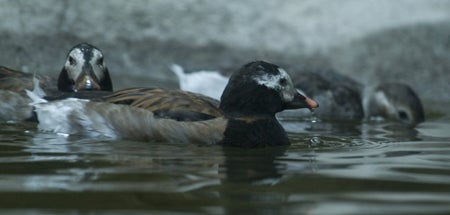SCIENTIFIC NAME:
Clangula hyemalis
OTHER NAMES:
Oldsquaw, sea pintail, cockertail, coween kakawi
STATUS:
Rare in winter, spring, and late fall in Gulf Coast and Tennessee Valley regions. Occasional in winter, spring, and late fall in Mountain and Inland Coastal Plain regions.
DESCRIPTION:
Oldsquaws are the trimmest of seaducks, with more tapered bodies than those of eiders and scoters. Depending on sex and physical condition, adult oldsquaws can weigh from 1.6 to 2.22 pounds and at maturity reach lengths up to 22 inches. Most noted for their long pointed central tail feathers, males are equally black and white during the fall and winter, with most prominent white sections being the head, sides, belly, and lower tail coverts. Spring and summer find the male with much more black and brown covering the body. The belly, sides, flanks, undertail coverts, and a patch on the face remain white during spring and summer.
Females are somewhat duller in color and do not have long central tail feathers. During fall and winter, the female has a white head except for dark streaks on the cheek and top of the head. The chest, breast, and belly are white, whereas the back and upper parts are black or brownish in color. Both sexes show all-dark unpatterned wings while flying.
DISTRIBUTION:
The oldsquaw inhabits the arctic and has a circumpolar breeding range that extends as far north as land occurs and as far south as tundra is found. They breed along the Arctic coasts in places such as Alaska, Canada, Eurasia, Iceland, and Greenland, just to name a few. Their winter range varies from seacoasts of California, Korea, northern Japan, northern France, North Carolina, and within the Great Lakes.
HABITAT:
Suitable habitats are oceans, large lakes, open bays and inshore waters. Breeding habitat is tundra pools and lakes.
FEEDING HABITS:
The oldsquaw is one of the deepest diving ducks, with birds being tangled in gill nets as deep as 240 feet. While most diving ducks use only their webbed feet to forage underwater, the oldsquaw uses its partially opened wings to help thrust itself beneath the surface. When foraging, the oldsquaw spends significantly more time submerged (as much as 3 to 4 times) than it spends above water. Winter diet primarily consists of animal items such as crustaceans, amphipods, and crabs. During the nesting season they switch to roots, buds, seeds, and sometimes domestic grains; the ducklings feed mainly on insect larvae.
LIFE HISTORY AND ECOLOGY:
Most oldsquaws do not breed until they are at least 2 years old. Pair bonding, which is very strong, occurs during winter or during spring migration and can take as long as 30 days to form. Even though this bond is exceptionally strong during the mating season, it appears to temporarily fall apart while the female is incubating the eggs. Most pairs return to the same grounds to nest year after year. Clutch sizes range from 2 to 11 (average of 7) olive green or water buff colored eggs per nest.
The nests are typically found on the ground near the water’s edge, sometimes only inches from other nests. Materials such as mosses, sedges, grasses, leaves, and down feathers are used to construct the nest. Roughly 26 days of incubation are required to successfully hatch the eggs. Nest predators include parasitic jaegers, long-tailed jaegers, foxes, and other birds.
REFERENCES:
http://www.birds.cornell.edu/AllAboutBirds/BirdGuide/Long-tailed_Duck_dt...
Bellrose, Frank C. 1980. Ducks, Geese & Swans of North America. Stackpole Books, Harrisburg, Pennsylvania, Pp. 385-393.
Bent, A.C. 1951. Life Histories of North American Wild Fowl (Order Anseres) – Ducks, Geese & Swans – Volume II. Dover Publications, Inc., Pp. 32-50.
Cassidy, James, R.L. Scheffel, G. Ferguson, G. Visalli, D. Palmer, C. Joh, and V. Gardner. 1990. Book of North American Birds. The Reader’s Digest Association, Inc., Pleasantville, New York, P. 369.
Earley, Chris G. 2005. Waterfowl of Eastern North America. Firefly Books, Buffalo, New York, Pp. 84-87.
Peterson, Roger T. 1980. Eastern Birds. Houghton Mifflin Company, Boston, New York. Pp. 56-67, Map 36.
AUTHOR:
Jud Easterwood, Wildlife Biologist, Division of Wildlife & Freshwater Fisheries






